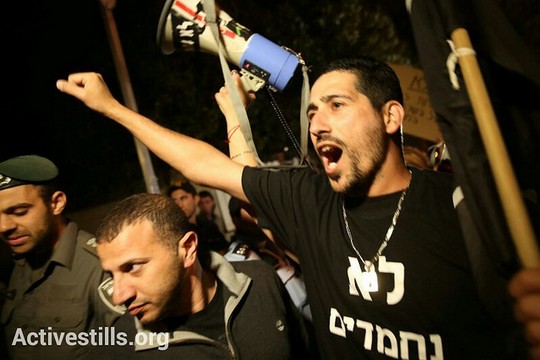Five years after Mizrahi Israelis offered their solidarity to the young men and women of the Arab Spring, it is time to say it loud and clear: real peace will come once we recognize the deep cultural and religious ties between Jews and Muslims of the region.
By Almog Behar

Five years ago in April of 2011, in the wake of the events of the Arab Spring, a group of Jewish descendants from Muslim and Arab countries, second and third generation Mizrahim in Israel, published an open letter of the women and men of the Middle East and North Africa, titled “Ruh Jedida: A New Spirit for 2011.” We looked on with great excitement at the role people our age played in the streets of the Arab world and in the demonstrations for freedom and change. We identified with the hopes for revolution that would bring down the tyrannical regimes in Tunisia and Egypt. We also looked on at the loss of life and great pain of the people of Syria and other places.
We hoped that a movement of people of our generation against oppressive regimes, and the call for change and democracy — which would allow all citizens to take part in the political process — would symbolize a dramatic moment in the history of the Middle East and North Africa. This was a region that had been torn apart in different directions by various forces — internal and external — which trampled over the political, economic, and cultural rights of most citizens.
We wanted to show solidarity as Israeli Jews who are descendants of Jewish communities that lived in the Middle East and North Africa for hundreds and thousands of years. We wanted to show that we too are part of the religious, cultural, and linguistic history of the region, even if we seem like we were “forgotten”: first in Israel, which imagines itself located between Europe and North America; and second in the Arab world, where it seems like the dichotomy between Jews and Arabs, and the attempt to view Jews as Europeans while erasing the history of Arab Jews, has become the norm. Even within Mizrahi communities, in Israel and across the world, we must admit that our past has been forgotten; in the wake of Western colonialism, Jewish nationalism and Arab nationalism, many of us were ashamed to acknowledge that we shared a common past with the Arab people.
We hoped that the Arab Spring would bring about a cross-generational moment in the history of the Middle East and North Africa. We hoped that they would bring freedoms, justice, and a fair distribution of resources. We turned to the young people in the Arab and Muslim world in a hope to create a dialogue that would include us in the history and culture of the region.

We wrote about how we live in state that pretends to represent enlightenment and democracy, while at the same time not representing large segments of the population. Instead, the state — on both sides of the Green Line — cares little for the economic rights of most people, is restricting freedoms and democracy, and builds racist walls in the face of Jewish and Arab Middle Eastern culture. We spoke about the connection between our struggle, as Mizrahim in Israel, and the Palestinian struggle, out of a belief that the Mizrahi struggle for economic, social, and cultural rights depends the understanding that political change cannot depend on Western powers, which exploited the region and its people for generations. Change must emerge from an inter-regional dialogue, from a connection between different struggles happening in Arab countries. Specifically, it must emerge from the struggle of Palestinian citizens of Israel for political and economic rights, and the Palestinian struggle in the West Bank and Gaza for freedom and an end military occupation.
Today, more than five years after Mohmed Bouazizi set himself on fire on in Tunisia on December 17, 2010, leading to a wave of demonstrations in the Arab world, the situation in Tunisia continues to raise our hopes for the establishment of a stable, democratic regime. On the other hand, the destruction and loss of life in Syria continues. We are pained by the inability to bring about an end to the cycle of violence and a democratic, just political arrangement that will guarantee representation to the Syrian people.
Meanwhile, the Israeli-Palestinian conflict continues, and its perception in the Israeli, Arab and international community as a Muslim-Jewish conflict only accelerates the erasure of Arab Jews from historical memory — wiping out more than 1,000 years of deep cultural, linguistic and theological ties between Islam and Judaism.
Now, more than ever, when the hatred between Jews and Muslims is seen as “natural,” it is important for us to emphasize the fact that our ancestors helped contribute to the cultural development of the region. The huge mutual contributions between Jewish and Arab cultures were nearly wiped out of our collective memory over the past few decades, in the wake of the nationalism that flooded the region in the 20th century. We can, however, see traces in many aspects of our cultures and religions, from music, to prayer, to linguistics and literature. For many Mizrahim in Israel, the culture of Muslim countries and the feeling of belonging to the region are an inseparable part of our identities.
It is my hope that our generation, across the Arab world — both Muslim and Jewish — will be the one to rebuild bridges — to jump over the walls and hatred of the previous generations, and will renew the deep dialogue that we cannot understand our own identities with it — between Jews, Sunnis, Shi’a, Christians. Between Arabs, Kurds, Amazighs, Turks, or Persians. Between Mizrahim and Ashkenazim, and Palestinians and Israelis. I hope we are able to remember all those previous generations that stood at the intersection between Judaism and Islam, between Jewish culture and Arab culture — who left us with a bountiful legacy.

I hope that as people with a common past, we will be able to look at a common future. Only inter-regional dialogue, whose goal is to fix and rebuild everything that was destroyed over the past generations, will provide the key for a renewed Andalusian Muslim-Jewish-Christian life, and, God willing, inshallah, real cultural and historical partnership in our countries. We meet many people in the Arab and Muslim world who wish to make these connections, and who hope to remember the Jewish legacy in countries such as Morocco, Egypt, Yemen, and Iraq.
If we are able to make the connection between the deep cultural ties and the theological ties from the time of Rabbi Sa’adia Gaon and Rabbi Moshe Ben Maimon and until today. If they become a part of our demand for distributive justice in our societies, for democratic, equal citizenship and an end to oppression and occupation, we will be able to propose a new political agenda in our countries that will be based on justice, equality, mutual respect, remedying historical injustices, and peace.
Almog Behar is a poet and literature critic. This article was first published in Hebrew on Haokets.


